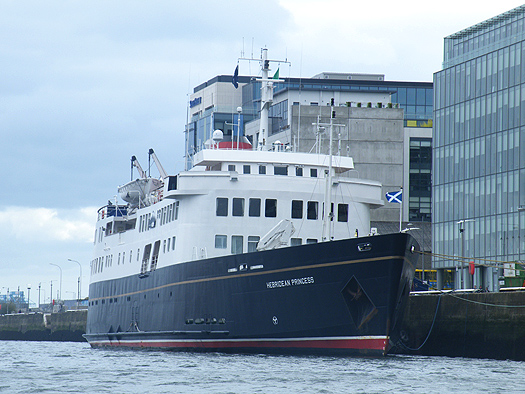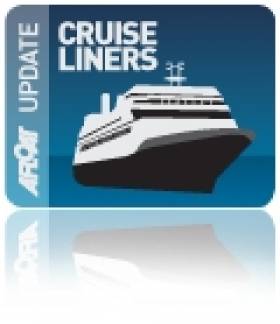Displaying items by tag: Royal Yacht Britannia
Former Scottish Lighthouse Tender to Be Converted into Luxury ‘Boatique’ Hotel Close to Last Royal Yacht Britannia
#FloatingHotel - The operators of UK's last royal yacht, Britannia, a major visitor attraction in Leith have acquired Fingal, a former Scottish tender of the Northern Lighthouse Board, which on occasions worked in Irish waters having called to Dun Laoghaire Harbour, writes Jehan Ashmore.
The near £1 million investment of Windsor Castle, the current name of the classically designed ship built in 1963, is to be converted into a 25 bedroom luxury 'boatique' hotel. She will be berthed permanently adjacent to Britannia in Edinburgh's historic port of Leith.
Fingal was the final ship built by Blythswood Shipbuilding Company in Glasgow. The Leith registered vessel spent most of her Northern Lighthouse Board career of 30 years from Oban followed by her last 6 years based in Stromness, Orkney.
On occasions Fingal shared duties between the three General Lighthouse Authority (GLA) that service aids to navigation throughout the waters of the UK and Ireland.
The tenders continue such operations between the three GLA's, they are the Northern Lighthouse Board (responsible for Scotland and the Isle of Man), Trinity House (England, Wales and the Channel Islands) and the Commissioners of Irish Lights for all waters around this island.
It was during a call by Fingal to Dun Laoghaire Harbour in 1994 that also included Trinity House's Mermaid. This was a rare meeting to witness as two GLA tenders not from Irish Lights were working in our waters.
Mermaid since sold currently works as Ocean Observer for Gardline Marine Services. As previously reported they also operate the former Irish Lights tender Granuaile dating from 1970 and renamed Ocean Seeker.
Having boarded the Fingal during that call to Dun Laoghaire, the 1,432 tonnes vessel had wonderful timber decks and wood panelled exteriors belonging to a bygone era.
In 2000 her career ended with NLB selling her to Tamahine Shipping and for many years she remained laid-up in the River Fal, Falmouth. Fortunately, the 239 foot long veteran vessel which is nearly two-thirds of the size of Britannia has been maintained to the highest standards.
Last Friday she arrived into Leith Docks (click PICS to enlarge). During the week she is relocate to a more permanent berth where she is to undergo a 18 month conversion to be completed for opening in Spring 2016.
According to a spokesperson in contact with Afloat.ie, the work is likely to be carried out by a combination of a team of 20 full-time maintenance staff from the Royal Britannia Yacht Trust (operators of the visitor attraction) and that of an interior design firm(s).
Developing a floating hotel adjacent to the Britannia represents natural organic growth for the Trust, which has the requisite management skills in-house, and servicing demand from both day visitors and evening event guests for quality accommodation.
Commenting on the announcement, Britannia's CEO Bob Downie said, 'After many years of searching for the right ship, we are delighted that we have been able to acquire this iconic vessel and look forward to opening Scotland's first boatique hotel. As a youngster growing up in Oban I have very fond memories of seeing the Fingal and I am delighted that the long-term future of another much loved classic vessel has been secured."
When the new 'boatique' opens she will be berthed adjacent to Britannia, which since her launch in 1953 had toured the world during her 44 years career serving as the British royal yacht for Queen Elizabeth II and members of the royal family.
She would sail to the western Scottish isles for the family's annual fortnight summer holiday cruise which would end by berthing at Aberdeen to allow the monarch to travel to her private residence at Balmoral Castle.
After travelling more than 1 million nautical miles, calling at 600 ports in 135 countries, Britannia was decommissioned in 1997. Her ship's bell as previously reported is on display in Trinity House, London, the headquarters of the English lighthouse authority which celebrates its 500th anniversary this year.
Britannia is officially Scotland's best visitor attraction for the last nine years and the UK's No.1 attraction by TripAdvisor for 2014. Annually she attracts 300,000 visitors. She is renowned for delivering the highest quality of customer experience and the addition of the hotel ship will fit neatly within the overall brand.
Queen Elizabeth's Chartered Cruiseship on Three-Day Visit to Dublin

Operated by Hebridean Island Cruises, the 5-star vessel which is for only 50 guests, has a reputation for exceptional service, fine dining and has a crew of 38. Accommodation is in thirty spacious, elegant and well-appointed cabins. On Princess Deck is located 'The Isle of Arran' (for deck plans click HERE) Suite which at 340sq ft is the largest and most expensive. The suite comprises a large separate dayroom, a spacious bedroom and a luxuriously equipped Victorian-style marble bathroom. In addition 10 cabins are designed especially for the single traveller. She has appeared in 1st place in UltraTravel Magazine's "10 Coolest Cruises"
Normally the Glasgow registered vessel operates throughout the Scottish highlands and islands, to lochs and remote mainland locations made accessible due to her small size. It is in these same waters that the Hebridean Princess has sailed in another guise as the humble car-ferry Columba (photos) for Caledonian MacBrayne. She was built in 1964 by Hall Russell, Aberdeen and served in this role until 1989 when she was sold and underwent an extensive conversion for the ultra-luxury cruise market.
Her three-day stay to Dublin is part of a Grand Celtic Cruise which started in Cardiff and which will include a call to Carlingford Lough tomorrow, followed by Strangford Lough, Bangor, Ballycastle, the Scottish isles of Jura and Crinan before disembarking in Oban, her home-port. The 10-night cruise inclusive of three-gala dinners cost €4,195 per person for a double cabin and €6,292 per person in a single-cabin.
A decade before Columba was launched, the Royal Yacht Britannia (5,682 tonnes) was commissioned in 1954. She was laid-down two years previously at John Brown & Co. Ltd, Clydebank and the year before she entered service she was launched by HM Queen Elizabeth II. For over four decades she served as the royal yacht until decommissioned in 1997. Her final foreign mission was to convey the last governor of Hong Kong and Prince of Wales from the former colony after its handover to China. She is now permanently moored as an exhibition ship in Edinburgh (Leith) for details click HERE.
Earlier this month Queen Elizabeth's namesake the 2010 built Cunard Line cruiseship Queen Elizabeth made her maiden Irish call to Dublin followed by Cork (Cobh). To read more on Dublin call click HERE and for Cork (Cobh) click HERE.
- Dublin Bay
- Dublin Port
- Dublin Docklands
- Cobh
- Cruise Liners
- Ports and Shipping
- Queen Elizabeth II
- Cruiseships
- Cunard Line
- The Convention Centre
- Cruise news
- Hebridean Princess
- Hebridean Princess Cruises
- Columba ferry
- Caledonian MacBrayne
- Hall Russell Shipyard
- Royal Yacht Britannia
- Hong Kong handover
- Prince of Wales
- Royal Yacht































































